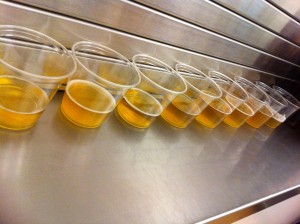In 2013 the inception of a club experiment crossed the minds of a number of officers and members. The idea grew and the Friends of the NBA provided the club with the ability to turn this local experiment into a potential expanded education opportunity.
In October 2013 NorthGate Brewing stepped up big time to help us brew a 5 barrel batch of beer to be used for this experiment. This resulted in a huge advantage in consistency and variable reduction. The recipe for the beer was a basic blonde beer, this allowed the yeast to more dominate. For example, if you pitched a Belgian yeast you would produce a Belgian blonde, pitch an American yeast and you would have an American blonde.
30 NBA Members signed up to pitch a yeast strain into their 5 gallon portion of wort. The diversity of strains was wide, giving us the opportunity to see how a wide variety yeast would affect the beer.
The following stains were used:
Wyeast 3726 Farmhouse
Wyeast 3725 Bier De Garde
Wyeast 3724 Belgian saison
Wyeast 3711 French Saison
Wyeast 3522 Belgian Ardennes
Wyeast 3463 Forbidden Fruit
Wyeast 2565 Kolsch
Wyeast 2308 Munich Lager
Wyeast 2278 Czech Pils
Wyeast 2112 California Lager
Wyeast 2001 Pilsner Urquell
Wyeast 2000 Budvar Lager
Wyeast 1968 London ESB
Wyeast 1469 West Yorkshire Ale
Wyeast 1335 British Ale II
Wyeast 1332 Northwest ale
Wyeast 1099 Whitbread Ale
WLP862 Cry Havoc
WLP644 Brett Brux Trois
WLP400 Belgian Wit Ale Yeast
WLP090 San Diego Super Yeast
WLP051 California V
WLP039 East Midlands Ale Yeast
WLP036 Dusseldorf Alt
WLP009 Australian Ale
Sanctification dreggs from Chip Walton
Safale US 05
Headwaters Ale
ECY 20 (The Mother Bugger)
Danstar Nottingham
Danstar BRY-97 (2nd generation)
The wort was brewed, and each participant walked away with a carboy 5 gallons of exactly the same wort. Once at their home, each pitched their strain of yeast and fermented at the appropriate temperatures for their personal strain. The fermentation schedule was the largest variable in this experiment. Basic information was collected from each participant including type of yeast, yeast starter method, fermentation schedule, and carbonation method.
The finished beers were tasted over three club meetings, starting with the more quickly attenuating ale yeasts, and finishing with our lager and Brett and sour strains. Each person present for the tasting completed a score sheet for each beer, subjectively scoring Aroma, Flavor, Mouthfeel, and General Impressions while also noting any off-flavors or specific aroma and flavor attributes.
All score sheets were then analyzed to determine average values, as well as trends seen across different yeast strains.
